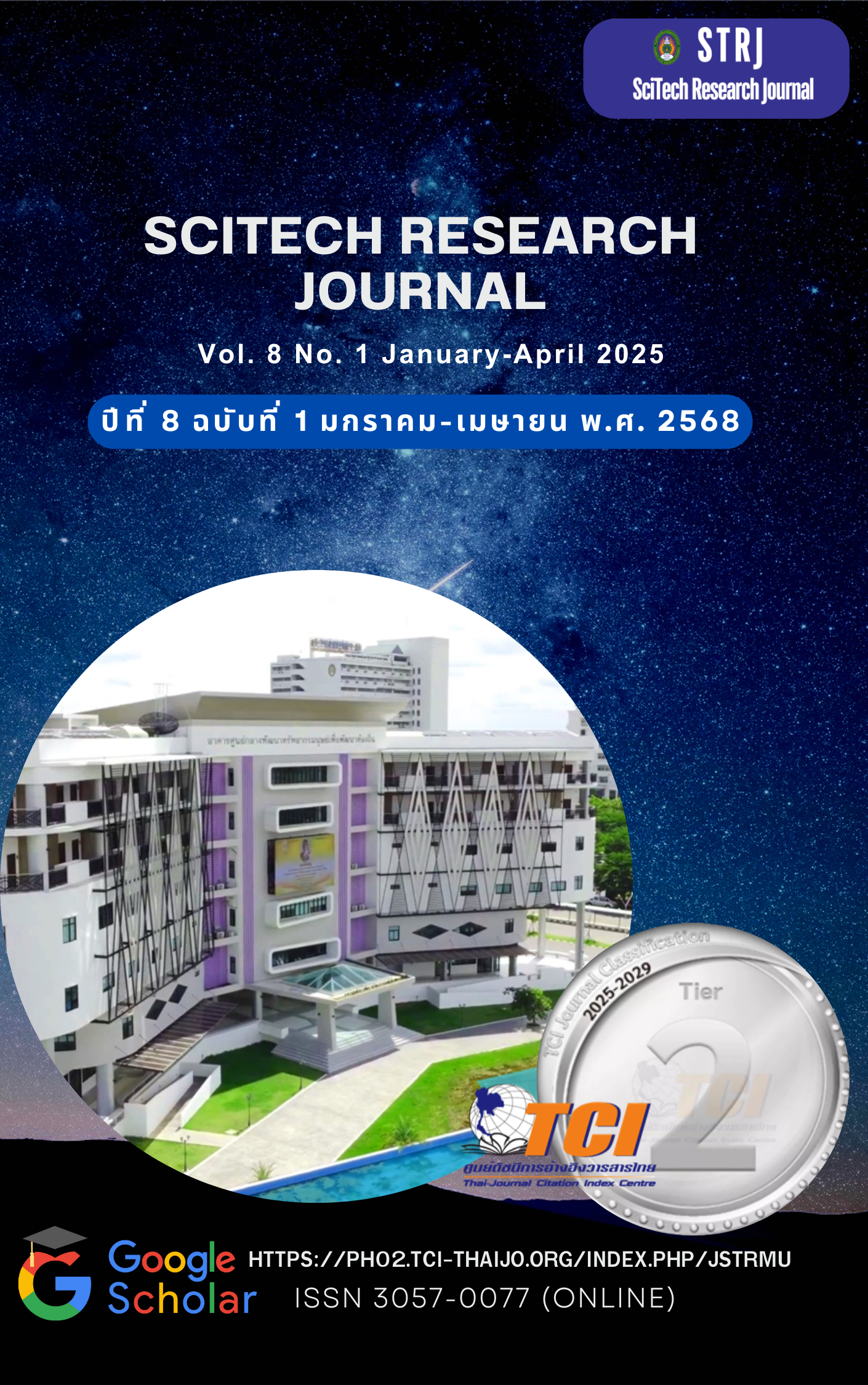Comparative study on galacturonic acid and its antioxidant activity of pectin from fruit waste peels
Keywords:
Galacturonic acid, Pectin, Antioxidants, Fruit waste peelsAbstract
The objective of this research is to compare the galacturonic acid and antioxidant activity of pectin extracted from five waste fruit peels: pomelo, pomegranate, lemon, guava, and passion fruit. The pectin from the fruit peels was obtained by acid hydrolysis and then precipitated with 99% ethanol. Pectin from passion fruit peel had the highest levels of galacturonic acid, followed by guava, pomegranate, pomelo, and lemon, respectively. The galacturonic acid of pectin was determined, and the antioxidant activity was studied using 2,2-diphenyl-1-picrylhydrazyl (DPPH) assay. According to the research, pectin from pomegranate peel has the highest antioxidant activity at all concentrations. These research findings not only enhance the value of waste fruit peels but also have the potential to be utilized in the food, medical, and pharmaceutical industries.
References
Amir H.A. (2009). Pectin and galacturonic acid from citrus wastes, Master thesis, School of Engineering, University of Borås.
Analese, R. (2023). Pectin: An overview of sources, extraction and applications in food products, biomedical, pharmaceutical and environmental issues. Food Chemistry Advances, 2, 100192.
Bachari, S. (2024). Ultrasonic depolymerization of pomegranate peel pectin: Effect of sonication time on antioxidant, α-amylase inhibitory, and prebiotic properties. Food Chemistry: 21, 101901.
Cariny, M. (2021). Structure and applications of pectin in food, biomedical, and pharmaceutical industry: A Review. Coatings, 11(8), 922.
Chee-Yuen, G. (2011). Extraction of antioxidant pectic-polysaccharide from mangosteen (Garcinia mangostana) rind: Optimization using response surface methodology, Carbohydrate Polymers, 83(2), 600-607.
Chinanat, W. (2023). The optimum conditions of extracting pectin from agricultural materials. Proceedings of the 5th Rajamangala University of Technology National Conference, 30 August–1 September 2023, Pattaya, Thailand.
Dranca, F. (2018). Extraction, purification and characterization of pectin from alternative sources with potential technological applications. Food Research International, 113, 327-350.
E. Delina, F. (2009). Active packaging of green mature tomatoes with pectin coating to extend the shelf life. Journal of Science- EUSL, 6(1), 1-9.
Elizabeth, D. (2014). Extraction of pectin from citrus fruit peel and its utilization in preparation of jelly. International Journal of Engineering Research & Technology, 3(5), 1925-1928.
Fatiha, A. (2017). Physicochemical and sensory quality of yogurt incorporated with pectin from peel of citrus sinensis. Food Science and Nutrition, 5(2), 358.
Frank, B.-P. (2021). The dietary fiber pectin: health benefits and potential for the treatment of allergies by modulation of Gut Microbiota. Curr Allergy Asthma Rep, 21(10), 43.
Fishman, M. (2000). Characterization of pectin, flash-extracted from orange albedo by microwave heating, under pressure. Carbohydrate Research, 323(1-4), 126-138.
Joel, G.-H. (2023). Exploring the effect of utilizing organic acid solutions in ultrasound-assisted extraction of pectin from apple pomace, and its potential for biomedical purposes. Heliyon, 9(7), e17736.
Korawit, S. (2020). Effects of fat replacement by pectin from dragon fruit peels on physicochemical properties of salad dressing. Dusit Thani college Journal, 14(3), 33. (in Thai)
LinShu, L. (2003). Pectin-based systems for colon-specific drug delivery via oral route, Biomaterials, 24(19).
Kumar, M. (2021). Jackfruit seed slimy sheath, a novel source of pectin: Studies on antioxidant activity, functional group, and structural morphology. Carbohydrate Polymer Technologies and Applications, 2, 100054.
Mahardiani, L. (2021). Potential edible coating of pectin obtained from banana peel for fruit preservation, Journal of Physics Conference Series, 1912(1).
Mariana, S. (2022). Microwave-assisted extraction of pectin from grape pomace. Scientific Reports, 12, 12722.
Martin, B. (2020). The effects of different dietary fiber pectin structures on the gastrointestinal immune barrier: impact via gut microbiota and direct effects on immune cells. PubMed Central, 52(9), 1364.
Mesbahi, G. (2005). A comparative study on functional properties of beet and citrus pectin in food systems. Food Hydrocolloids, 19(4), 731-738.
Ongard, D. (2010). Comparison of extracted pectin from three kinds of guava (Psidium Guajava L.). Master of Education Degree in Chemistry, Srinakarinwirot University. (in Thai)
Rawisada, P. (2024). Impact of pectin edible coating extracted from cacao shell powder on postharvest quality attributes of tomato (Lycopersicon esculentum Mill.) fruit during storage. Food Control, 155, 110023. (in Thai)
Riyamol, (2023). Recent advances in the extraction of pectin from various sources and industrial applications. ACS Omega, 8, 46309-46324.
Sun, D. (2020). Physicochemical properties and antioxidant activity of pectin from hawthorn wine pomace: A comparison of different extraction methods. International Journal of Biological Macromolecules, 158, 1239-1247.
Sun, H.L. (2014). Apple pectin, a dietary fiber, ameliorates myocardial injury by inhibiting apoptosis in a rat model of ischemia/reperfusion. PudMed Central,8(4), 395.
Swarup, R. (2023). Recent progress in pectin extraction, characterization, and pectin-based films for active food packaging applications: A review. International Journal of Biological Macromolecules, 239, 124248.
Takahiro, F. (2009). Structural modifications of sugar beet pectin and the relationship of structure to functionality, Food Hydrocolloids, 25(2), 221-229.
Vinay, C. (2022). Current advancements in pectin: extraction, properties and multifunctional applications. Foods, 11(17), 2683.
Wathoni, N. (2019). Characterization and antioxidant activity of pectin from Indonesian mangosteen (Garcinia mangostana L.) rind. Heliyon, 5(8), e02299.
Wei, Z. (2024). Modification of pectin with high-pressure processing treatment of fresh orange peel before pectin extraction: Part II. The effects on gelling capacity and emulsifying properties. Food Hydrocolloids, 149, 109536.
Welela, M. (2022). Pharmaceutical and drug delivery applications of pectin and its modified nanocomposites. Heliyon, 8(9), e10654.
Xudong, Y. (2022). Gelation behaviors of some special plant-sourced pectins: A review inspired by examples from traditional gel foods in China. Trends in Food Science & Technology, 126, 26-40.
Yanming, R. (2023). Pectin from citrus unshiu marc. alleviates glucose and lipid metabolism by regulating the gut microbiota and metabolites. Food, 12(22), 4094.
Yanqing, Z. (2023). Anti-diabetic effect of modified ‘Guanximiyou’ pummelo peel pectin on type 2 diabetic mice via gut microbiota. International Journal of Biological Macromolecules, 242, 124865.



